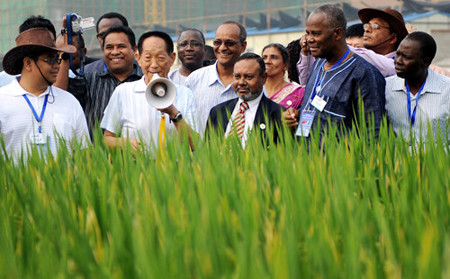
SUPER RICE: Yuan Longping (with loud speaker), introduces the Y Two Superior No.2 strain of rice to foreign visitors to his experimental field in Longhui County, Hunan Province, on September 29, 2011.
At the beginning of 2011, major grain producing provinces in central and east China experienced a prolonged drought that stretched for more than three months.
Then in summer, a severe drought left millions short of drinking water in southwest China. Even the usually water-rich regions along the middle and lower reaches of the Yangtze River were not spared. In May, they suffered from the worst drought in 50 years, heavy rains eventually relieved the drought but these rains in turn caused serious flooding.
Despite the disasters, last year saw a bumper harvest in China.
On December 16, the Ministry of Agriculture said that the total grain output in 2011 reached a historical high of 571.2 billion kg, up 24.75 billion kg, or 4.5 percent, from 2010.
China's grain yield had been on the rise for eight consecutive years. Between 2004 and 2011, grain production increased by 140.5 billion kg, with an annual increase of 17.5 billion kg, the largest since 1949.
"In 2011, the yield of the three staple grains—rice, wheat and corn—all increased, with a total increase of 22.25 billion kg, a rise across all three crops has been rare in the last two decades," said Chen Yinshan, chief economist and spokesperson of the Ministry of Agriculture.
Minister of Agriculture Han Changfu attributed the increase to favorable policies, infrastructure construction and scientific and technological support services.
Grain security
"Grain production is a strategic industry, and keeping the country's billion plus population fed is the most important thing for China," Han said.
Statistics from the Agriculture and Rural Affairs Committee of the National People's Congress show that over the past few decades in China, an average of 7.39 million people have been added to the population each year, whereas the area of arable land has been dropping.
Currently, there are 121.9 million hectares of arable land in China, 8.2 million hectares less than that in 1997. On average, China has 0.092 hectare of arable land per capita, which is 40 percent less than the global average.
With a large population and low per-capita arable land acreage, China faces bigger and bigger grain security challenges.
China imports 80 percent of its soybean requirement, 60 percent of its edible oil, 30 percent of its cotton and 20 percent of the sugar consumed in the country. As more corn is needed for animal feed and other corn products, the domestic supply has fallen short and imported corn is now being used to fill the gap.
Also, China has to import more than 70 percent of the advanced processing equipment it uses in agricultural production, whereas domestically produced agricultural machinery is only up to the standards of machinery produced in developed countries in the 1970s.
"To ensure grain security, Chinese people's rice bowl should only be filled by themselves," Han said.
According to Han, the total volume of grain traded worldwide is usually about 250 million tons, less than half of China's total grain output, and the annual global trade volume of rice is about 25-30 million tons, about 15 percent of rice consumption in China.

Copyright ©1999-2011 Chinanews.com. All rights reserved.
Reproduction in whole or in part without permission is prohibited.